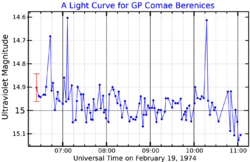Astronomy:GP Comae Berenices
Coordinates: ![]() 13h 05m 42.4008s, +18° 01′ 03.7653″
13h 05m 42.4008s, +18° 01′ 03.7653″
 An ultraviolet band light curve for GP Comae Berenices, adapted from Smak (1975).[1] The error bar shown on the leftmost point applies to all points. | |
| Observation data Equinox J2000.0]] (ICRS) | |
|---|---|
| Constellation | Coma Berenices |
| Right ascension | 13h 05m 42.401s[2] |
| Declination | +18° 01′ 03.76″[2] |
| Apparent magnitude (V) | 15.69[3] |
| Characteristics | |
| Evolutionary stage | White dwarf |
| Spectral type | DBe[4] |
| Apparent magnitude (g) | 15.929[2] |
| Variable type | AM CVn |
| Astrometry | |
| Proper motion (μ) | RA: −344.92±0.06[2] mas/yr Dec.: 34.85±0.06[2] mas/yr |
| Parallax (π) | 13.7306 ± 0.0452[2] mas |
| Distance | 237.5 ± 0.8 ly (72.8 ± 0.2 pc) |
| Details[5] | |
| Mass | 0.59±0.09 M☉ |
| Temperature | 14,800±500 K |
| Other designations | |
| Database references | |
| SIMBAD | data |
GP Comae Berenices, abbreviated to GP Com and also known as G 61-29, is a star system composed of a white dwarf orbited by a planetary mass object, likely the highly eroded core of another white dwarf star.[7] The white dwarf is slowly accreting material from its satellite at a rate of (3.5±0.5)×10−11 M☉/year and was proven[8] to be a low-activity AM CVn star.[7][5] The star system is showing signs of a high abundance of ionized nitrogen from the accretion disk around the primary.[9]
Planetary system
The material emitted from the planetary mass companion is mostly helium, with a molar ratio of nitrogen up to 1.7%, very low neon levels and other elements not detectable at all.[10] Approximately half of the luminosity of the system comes from the accretion disk.[5] The planetary object is suspected to contain a strange quark matter core due to its unusually high density, which must be above 187.5 g/cm3 to prevent tidal disruption; the theoretical bound for planets composed solely of ordinary matter is on the order of 30 g/cm3. The object's orbit is expected to decay within 100 million years due to gravitational wave emission.[11]
| Companion (in order from star) |
Mass | Semimajor axis (AU) |
Orbital period (seconds) |
Eccentricity | Inclination | Radius |
|---|---|---|---|---|---|---|
| b | 10.5±1.5 MJ | 0.0014[11] | 2794 | 0 | 59.5±14.5[9]° | ≤ 0.420±0.020 RJ |
References
- ↑ Smak, J. (January 1975). "The helium emission-line object G 61-29". Acta Astronomica 25: 227–233. Bibcode: 1975AcA....25..227S. https://ui.adsabs.harvard.edu/abs/1975AcA....25..227S. Retrieved 12 December 2021.
- ↑ 2.0 2.1 2.2 2.3 2.4 Brown, A. G. A. (2021). "Gaia Early Data Release 3: Summary of the contents and survey properties". Astronomy & Astrophysics 649: A1. doi:10.1051/0004-6361/202039657. Bibcode: 2021A&A...649A...1G. Gaia EDR3 record for this source at VizieR.
- ↑ Samus', N. N.; Kazarovets, E. V.; Durlevich, O. V.; Kireeva, N. N.; Pastukhova, E. N. (2017). "General catalogue of variable stars: Version GCVS 5.1". Astronomy Reports 61 (1): 80. doi:10.1134/S1063772917010085. Bibcode: 2017ARep...61...80S.
- ↑ Burbidge, E. M.; Strittmatter, P. A. (1971), "G61 - 29, a Helium Emission-Line Star", The Astrophysical Journal 170: L39, doi:10.1086/180836, Bibcode: 1971ApJ...170L..39B
- ↑ 5.0 5.1 5.2 5.3 Sion, Edward M.; Linnell, Albert P.; Godon, Patrick; Ballouz, Ronald-Louis (2011), "THE HOT COMPONENTS OF AM CVN HELIUM CATACLYSMICS", The Astrophysical Journal 741 (1): 63, doi:10.1088/0004-637X/741/1/63, Bibcode: 2011ApJ...741...63S
- ↑ "G 61-29". SIMBAD. Centre de données astronomiques de Strasbourg. http://simbad.u-strasbg.fr/simbad/sim-basic?Ident=G+61-29.
- ↑ 7.0 7.1 Zhang, Xian-Fei; Liu, Jin-Zhong; Jeffery, C. Simon; Hall, Philip D.; Bi, Shao-Lan (2018), "The double helium-white dwarf channel for the formation of AM CVN binaries", Research in Astronomy and Astrophysics 18 (1): 009, doi:10.1088/1674-4527/18/1/9, Bibcode: 2018RAA....18....9Z
- ↑ Morales-Rueda, L.; Marsh, T. R.; Steeghs, D.; Unda-Sanzana, E.; Wood, J. H.; North, R. C. (2003), "New results on GP Com", Astronomy & Astrophysics 405: 249–261, doi:10.1051/0004-6361:20030552, Bibcode: 2003A&A...405..249M
- ↑ 9.0 9.1 Kupfer, T.; Steeghs, D.; Groot, P. J.; Marsh, T. R.; Nelemans, G.; Roelofs, G. H. A. (2016), "UVES and X-Shooter spectroscopy of the emission line AM CVN systems GP Com and V396 Hya", Monthly Notices of the Royal Astronomical Society 457 (2): 1828, doi:10.1093/mnras/stw126, Bibcode: 2016MNRAS.457.1828K
- ↑ Nelemans, G.; Yungelson, L. R.; Sluys, M. V. van der; Tout, Christopher A. (2009), "The chemical composition of donors in AM CVN stars and ultracompact X-ray binaries: Observational tests of their formation", Monthly Notices of the Royal Astronomical Society 401 (2): 1347–1359, doi:10.1111/j.1365-2966.2009.15731.x
- ↑ 11.0 11.1 Kuerban, Abudushataer; Geng, Jin-Jun; Huang, Yong-Feng; Zong, Hong-Shi; Gong, Hang (2020), "Close-in Exoplanets as Candidates for Strange Quark Matter Objects", The Astrophysical Journal 890 (1): 41, doi:10.3847/1538-4357/ab698b, Bibcode: 2020ApJ...890...41K
 |

